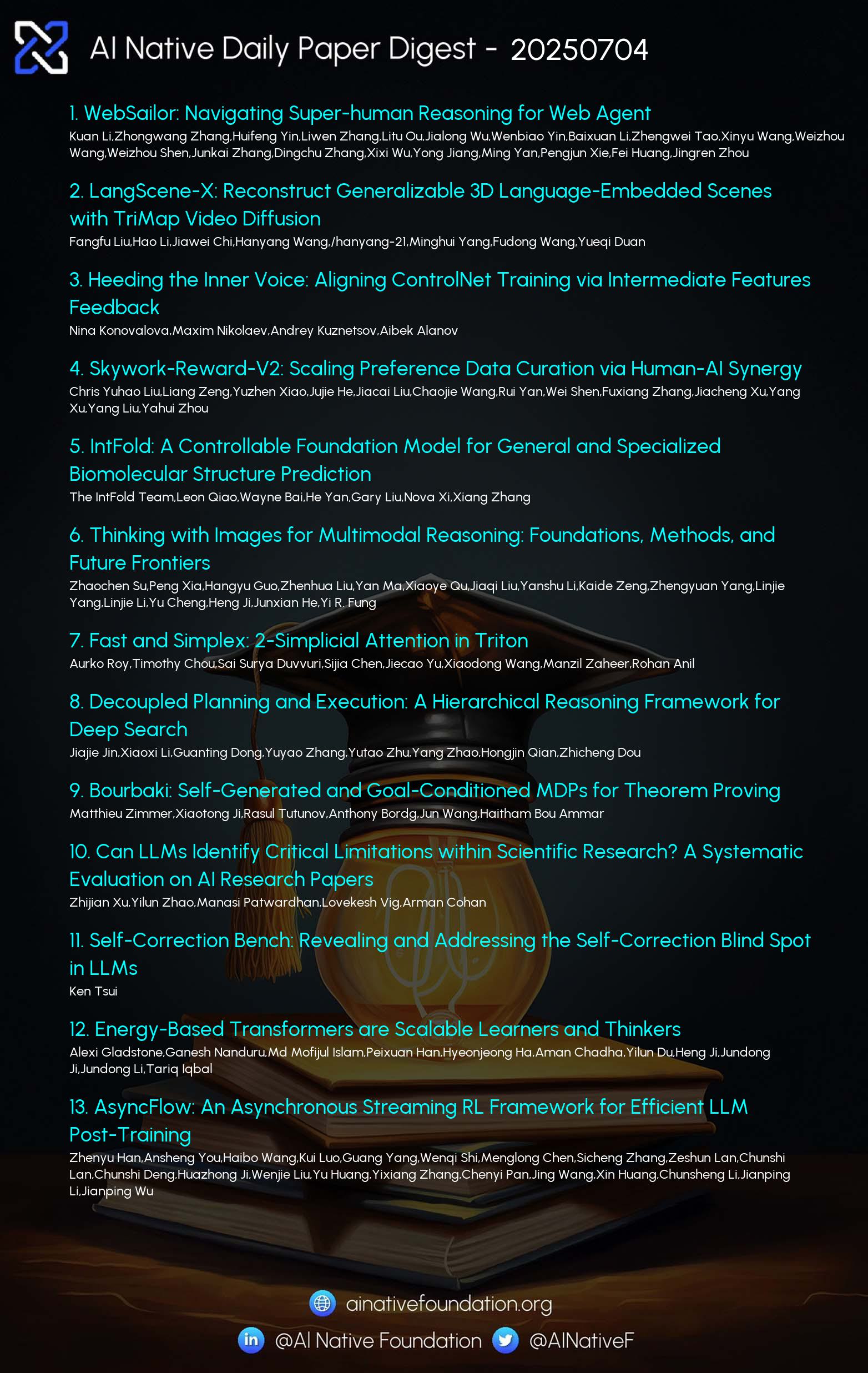AI Native Daily Paper Digest – 20250704
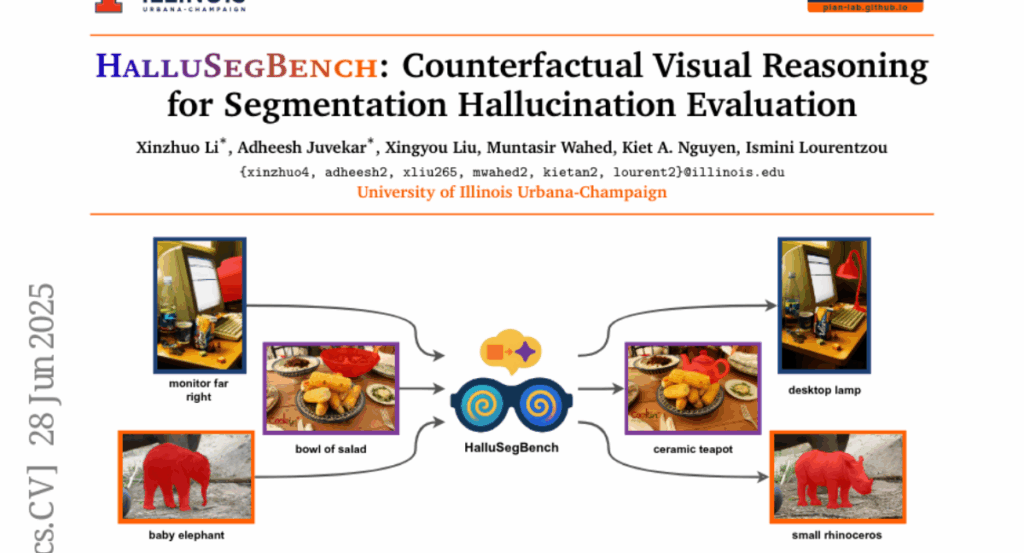
1. WebSailor: Navigating Super-human Reasoning for Web Agent
🔑 Keywords: WebSailor, LLM, proprietary agents, reasoning capabilities, complex information-seeking tasks
💡 Category: Reinforcement Learning
🌟 Research Objective:
– To enhance LLMs by improving their reasoning capabilities in complex information-seeking tasks to match proprietary agents.
🛠️ Research Methods:
– Utilization of structured sampling, information obfuscation, and an efficient RL algorithm known as Duplicating Sampling Policy Optimization (DUPO).
💬 Research Conclusions:
– WebSailor significantly outperforms all open-source agents in complex information-seeking tasks, effectively matching the performance of proprietary agents.
👉 Paper link: https://huggingface.co/papers/2507.02592
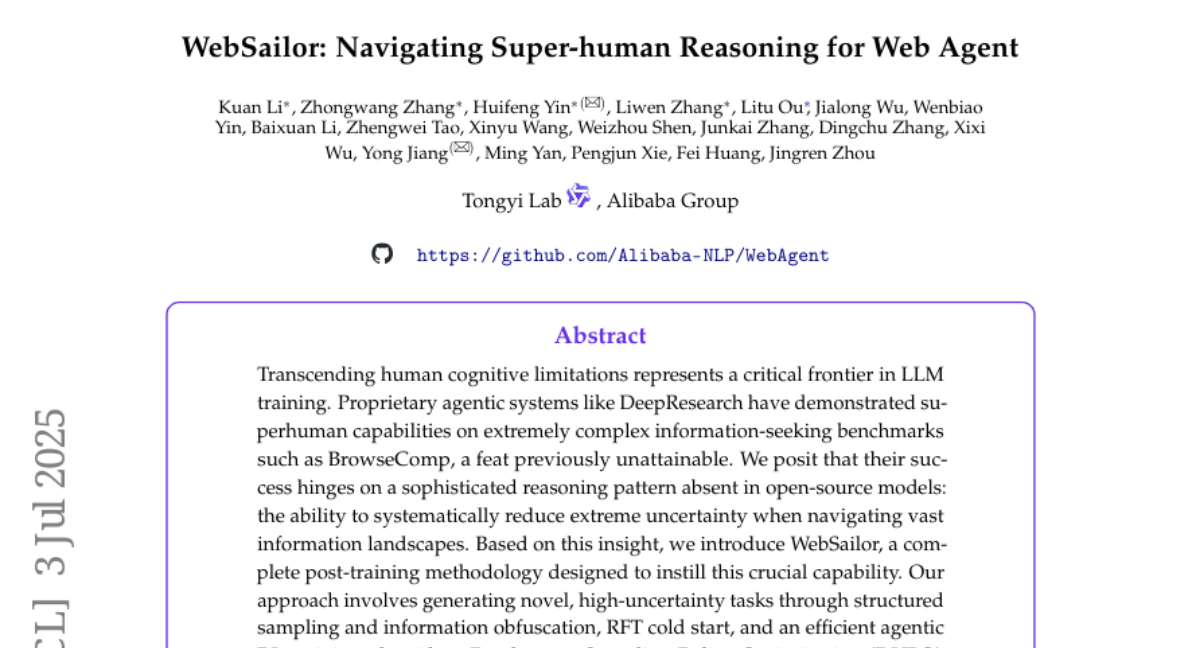
2. LangScene-X: Reconstruct Generalizable 3D Language-Embedded Scenes with TriMap Video Diffusion
🔑 Keywords: LangScene-X, 3D scene reconstruction, TriMap video diffusion model, Language Quantized Compressor
💡 Category: Generative Models
🌟 Research Objective:
– Introduce LangScene-X to generate 3D consistent information from sparse views for scene reconstruction and understanding.
🛠️ Research Methods:
– Utilize TriMap video diffusion model for generating appearance, geometry, and semantics.
– Employ Language Quantized Compressor for encoding language embeddings, enabling cross-scene generalization.
💬 Research Conclusions:
– LangScene-X demonstrates superior quality and generalizability over state-of-the-art methods in experiments with real-world data.
👉 Paper link: https://huggingface.co/papers/2507.02813
3. Heeding the Inner Voice: Aligning ControlNet Training via Intermediate Features Feedback
🔑 Keywords: InnerControl, text-to-image diffusion models, ControlNet, alignment loss, spatial consistency
💡 Category: Generative Models
🌟 Research Objective:
– To enhance spatial control and improve generation quality in text-to-image diffusion models by enforcing spatial consistency across all diffusion steps.
🛠️ Research Methods:
– The implementation of InnerControl uses lightweight convolutional probes to reconstruct input control signals from intermediate UNet features at each denoising step.
💬 Research Conclusions:
– InnerControl minimizes discrepancies throughout the entire diffusion process, improving control fidelity and generation quality, achieving state-of-the-art performance.
👉 Paper link: https://huggingface.co/papers/2507.02321
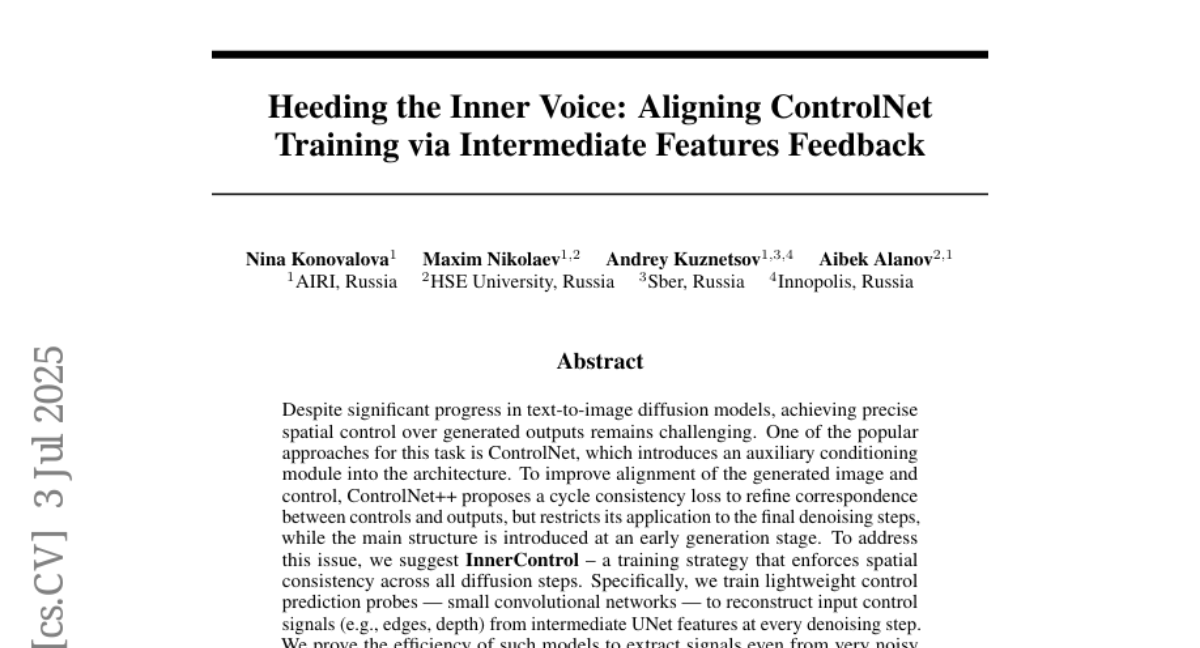
4. Skywork-Reward-V2: Scaling Preference Data Curation via Human-AI Synergy
🔑 Keywords: AI Native, Reinforcement Learning, Human-AI synergy, Preference Datasets
💡 Category: Reinforcement Learning
🌟 Research Objective:
– The objective was to improve the quality and performance of open reward models in reinforcement learning from human feedback by addressing limitations in current preference datasets and utilizing a large-scale dataset, SynPref-40M.
🛠️ Research Methods:
– A synergistic human-AI curation pipeline was established, combining human annotation quality with AI scalability, and training involved a suite of models called Skywork-Reward-V2 on a subset of 26 million preference pairs.
💬 Research Conclusions:
– The Skywork-Reward-V2 models demonstrated state-of-the-art performance across seven major benchmarks, showing versatility, alignment with human preferences, and highlighting the significant potential of human-AI curation synergy in enhancing data quality.
👉 Paper link: https://huggingface.co/papers/2507.01352
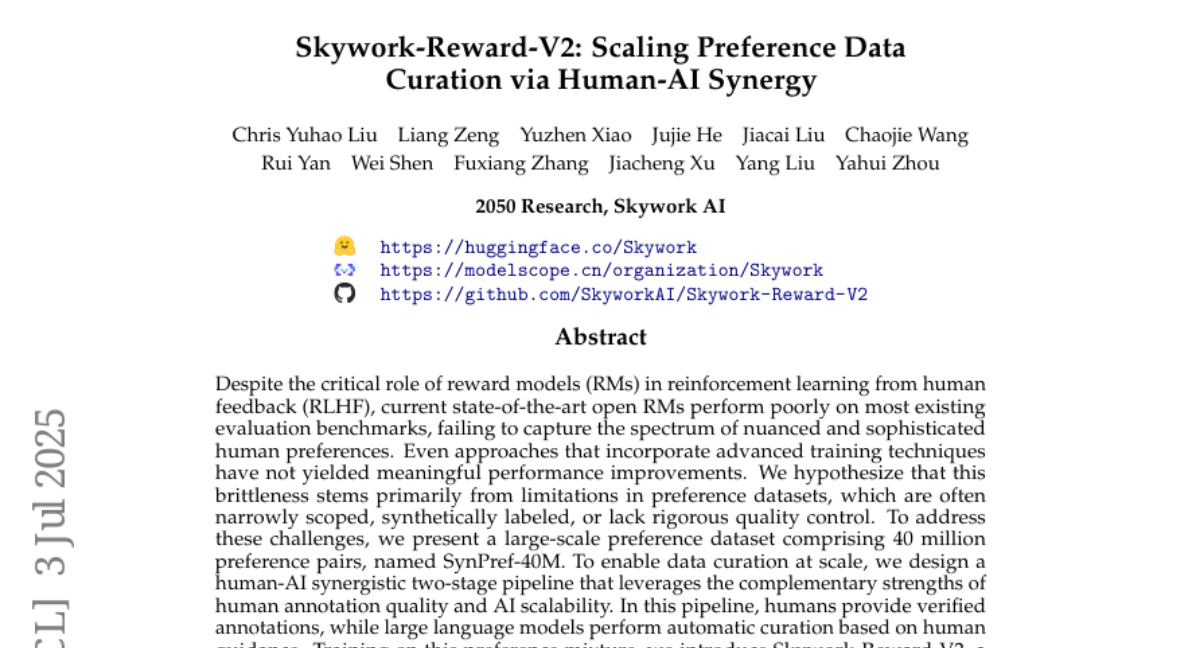
5. IntFold: A Controllable Foundation Model for General and Specialized Biomolecular Structure Prediction
🔑 Keywords: IntFold, biomolecular structure prediction, attention kernel, AlphaFold3, confidence head
💡 Category: Foundations of AI
🌟 Research Objective:
– Introduce IntFold, a controllable foundation model for general and specialized biomolecular structure prediction.
🛠️ Research Methods:
– Utilize a customized attention kernel and adapters for predictive tasks.
– Implement a novel confidence head for docking quality assessment.
💬 Research Conclusions:
– IntFold achieves predictive accuracy on par with or exceeding state-of-the-art models like AlphaFold3.
– Capable of advanced predictions, including allosteric states, constrained structures, and binding affinity assessment.
– Provides nuanced docking quality assessments, especially for complex targets like antibody-antigen complexes.
👉 Paper link: https://huggingface.co/papers/2507.02025
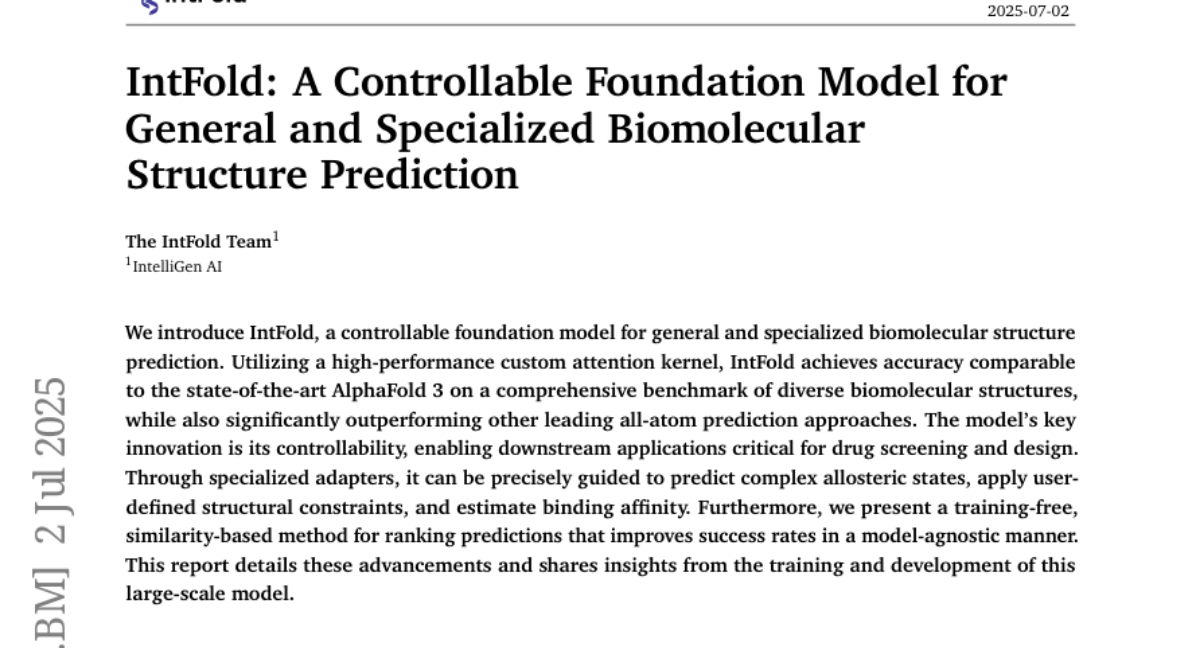
6. Thinking with Images for Multimodal Reasoning: Foundations, Methods, and Future Frontiers
🔑 Keywords: Multimodal reasoning, Chain-of-Thought, dynamic mental sketchpad, AI Native, cognitive workspace
💡 Category: Multi-Modal Learning
🌟 Research Objective:
– The study aims to map the evolution of multimodal reasoning models towards a more integrated use of visual information, transitioning from static to dynamic roles in cognitive processes.
🛠️ Research Methods:
– The research provides a comprehensive review of foundational principles, outlines a three-stage framework of multimodal reasoning, and analyzes evaluation benchmarks and applications.
💬 Research Conclusions:
– The paper highlights a paradigm shift in AI from static image interaction to dynamic cognitive workspaces and identifies challenges and future directions in achieving more powerful and human-aligned multimodal AI.
👉 Paper link: https://huggingface.co/papers/2506.23918
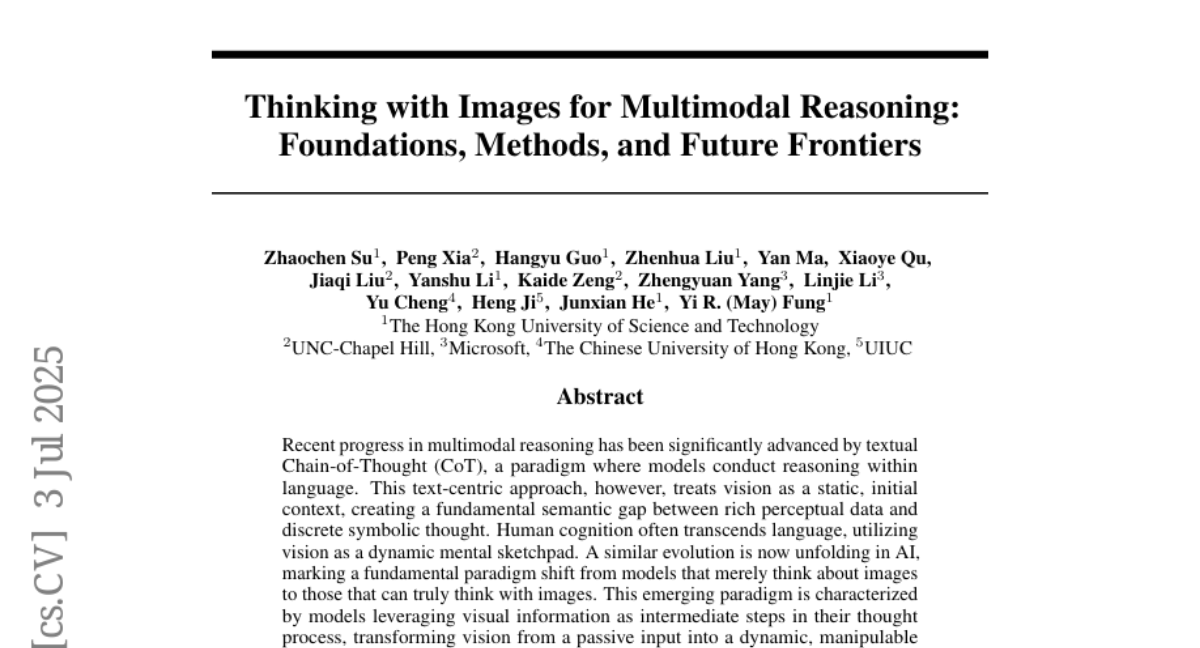
7. Decoupled Planning and Execution: A Hierarchical Reasoning Framework for Deep Search
🔑 Keywords: Hierarchical Framework, Strategic Planning, Specialized Execution, Complex Search Tasks, Cross-Modal Deep Search
💡 Category: Knowledge Representation and Reasoning
🌟 Research Objective:
– Introduce HiRA, a hierarchical framework designed to improve efficiency and answer quality in deep search tasks by separating strategic planning from specialized execution.
🛠️ Research Methods:
– Decompose complex search tasks into focused subtasks handled by domain-specific agents equipped with external tools and reasoning capabilities.
💬 Research Conclusions:
– HiRA significantly outperforms existing retrieval-augmented generation and agent-based systems, showing improvements in answer quality and efficiency.
👉 Paper link: https://huggingface.co/papers/2507.02652
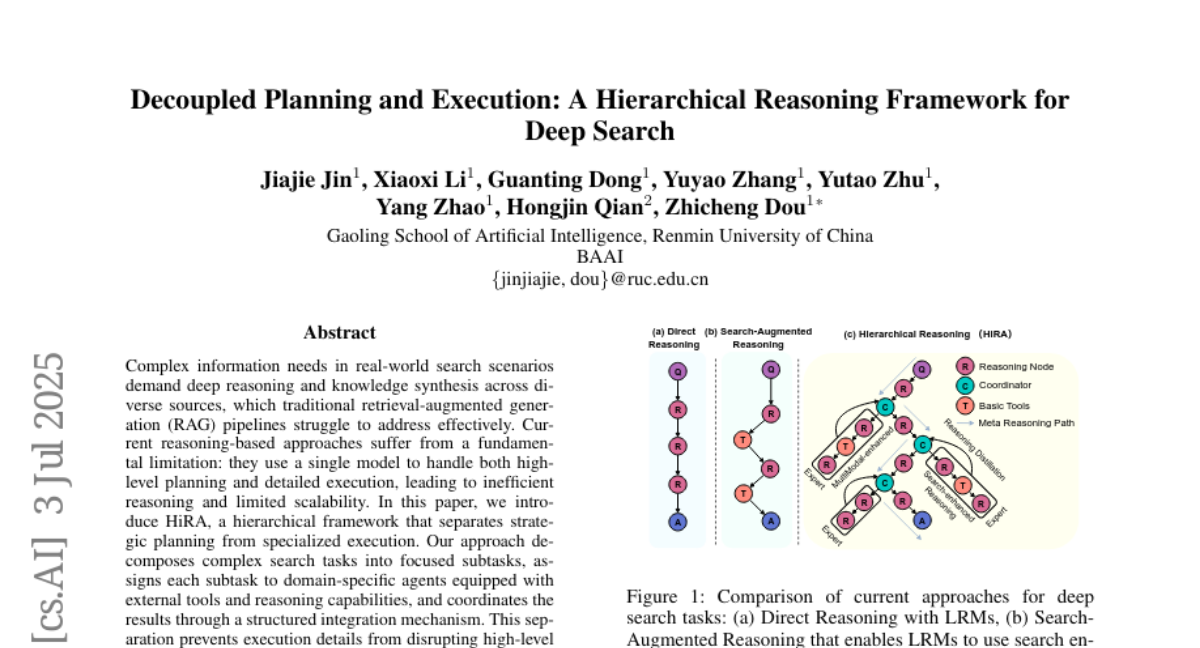
8. Fast and Simplex: 2-Simplicial Attention in Triton
🔑 Keywords: 2-simplicial Transformer, token efficiency, Triton kernel, scaling laws, reasoning tasks
💡 Category: Knowledge Representation and Reasoning
🌟 Research Objective:
– The study aims to explore improvements in token efficiency for knowledge and reasoning tasks using the 2-simplicial Transformer over standard Transformers.
🛠️ Research Methods:
– Utilizes a 2-simplicial Transformer architecture with efficient Trilinear function implementation through a Triton kernel, generalizing standard dot-product attention.
💬 Research Conclusions:
– The 2-simplicial Transformer demonstrates superior token efficiency and performs better on mathematics, coding, reasoning, and logic tasks compared to standard Transformers, altering the scaling laws for these tasks.
👉 Paper link: https://huggingface.co/papers/2507.02754
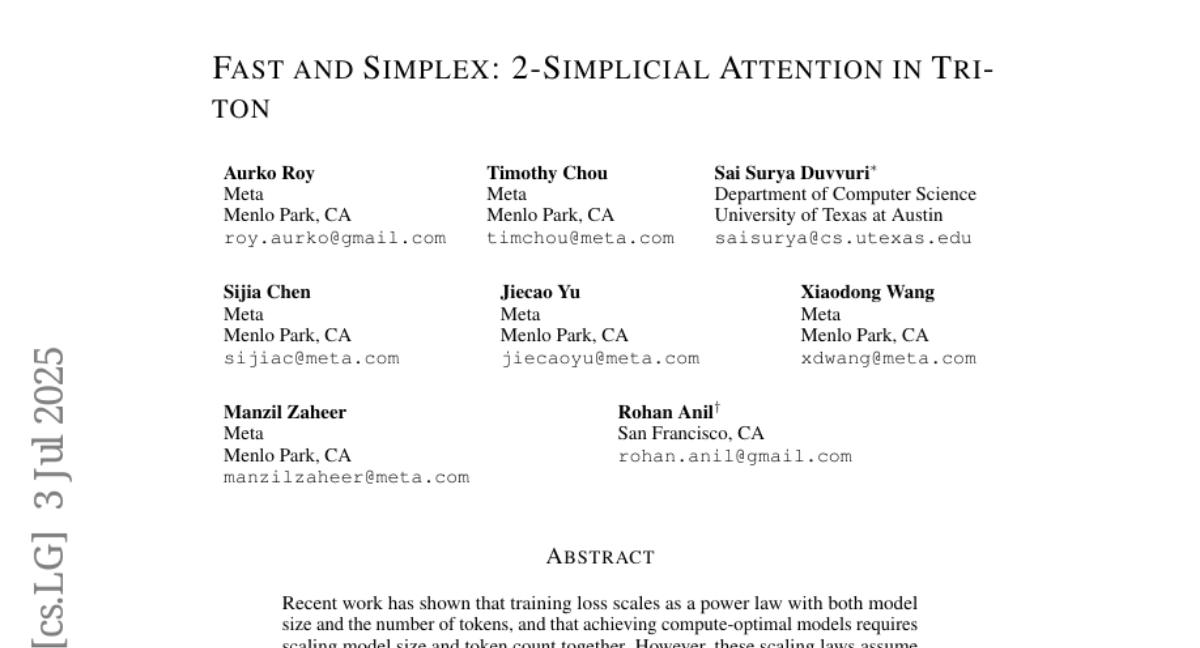
9. Bourbaki: Self-Generated and Goal-Conditioned MDPs for Theorem Proving
🔑 Keywords: LLMs, Automated Theorem Proving, sG-MDPs, MCTS, Bourbaki
💡 Category: Knowledge Representation and Reasoning
🌟 Research Objective:
– To improve the performance of large language models (LLMs) in the context of automated theorem proving (ATP), particularly on complex benchmarks like PutnamBench.
🛠️ Research Methods:
– Utilization of self-generated goal-conditioned MDPs (sG-MDPs) and Monte Carlo Tree Search (MCTS)-like algorithms to generate and pursue subgoals based on the evolving proof state.
💬 Research Conclusions:
– The proposed framework, instantiated in the Bourbaki system, achieved state-of-the-art results by solving 26 problems on PutnamBench with models at the 7B scale.
👉 Paper link: https://huggingface.co/papers/2507.02726
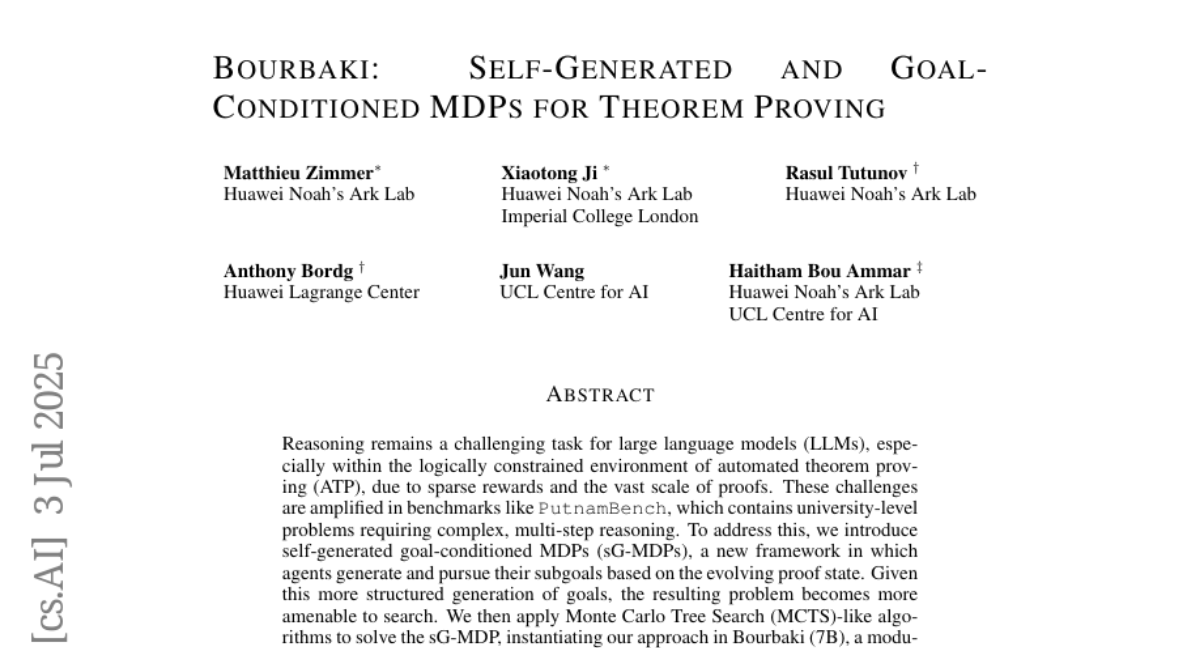
10. Can LLMs Identify Critical Limitations within Scientific Research? A Systematic Evaluation on AI Research Papers
🔑 Keywords: LimitGen, LLMs, peer review, literature retrieval, AI
💡 Category: Natural Language Processing
🌟 Research Objective:
– The paper introduces LimitGen, a benchmark designed to evaluate LLMs in identifying limitations in scientific research and to improve their feedback by using literature retrieval.
🛠️ Research Methods:
– A taxonomy of limitation types in scientific research focused on AI is developed to guide the study.
– LimitGen consists of two subsets: a synthetic dataset (LimitGen-Syn) and a human-written dataset (LimitGen-Human).
💬 Research Conclusions:
– The enhanced LLM systems, supported by literature retrieval, are better equipped to generate research paper limitations and provide more substantial peer review feedback.
👉 Paper link: https://huggingface.co/papers/2507.02694
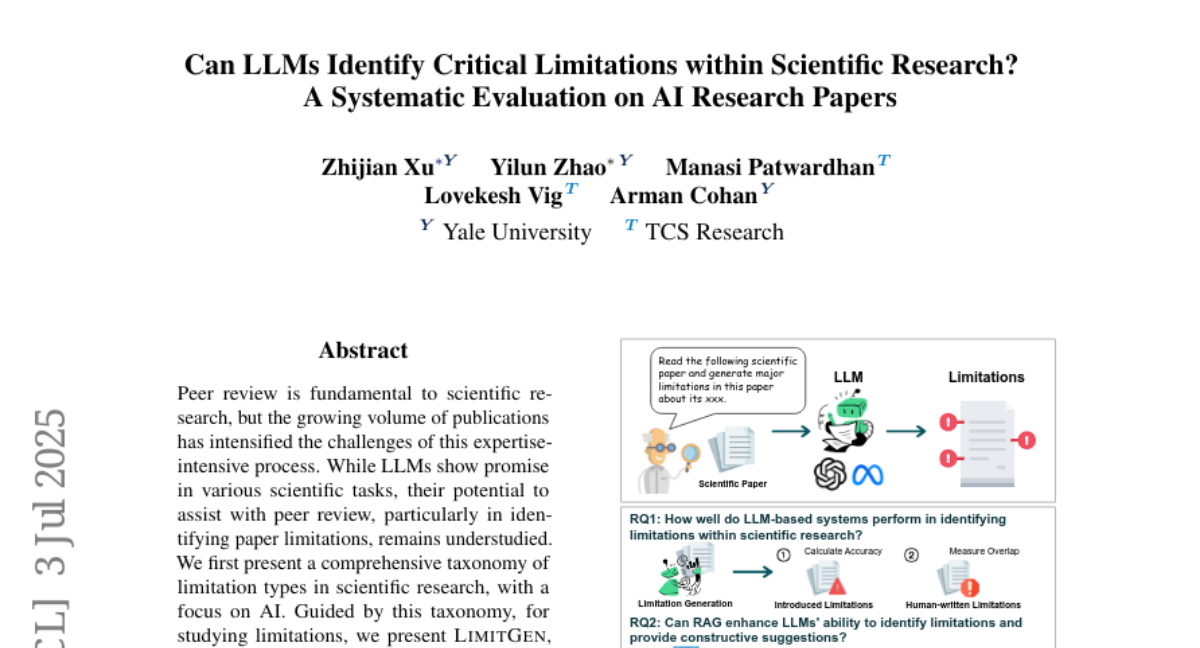
11. Energy-Based Transformers are Scalable Learners and Thinkers
🔑 Keywords: Energy-Based Transformers, System 2 Thinking, Unsupervised Learning, Scaling Rate, Inference
💡 Category: Multi-Modal Learning
🌟 Research Objective:
– The research explores the potential to generalize System 2 Thinking in AI models using unsupervised learning without additional supervision or training.
🛠️ Research Methods:
– The introduction of Energy-Based Transformers (EBTs), a new class of Energy-Based Models (EBMs) that utilize gradient descent-based energy minimization to make predictions.
💬 Research Conclusions:
– EBTs demonstrated superior scaling during training and enhanced inference performance over existing models, including achieving a 35% higher scaling rate and a 29% performance improvement on language tasks.
👉 Paper link: https://huggingface.co/papers/2507.02092
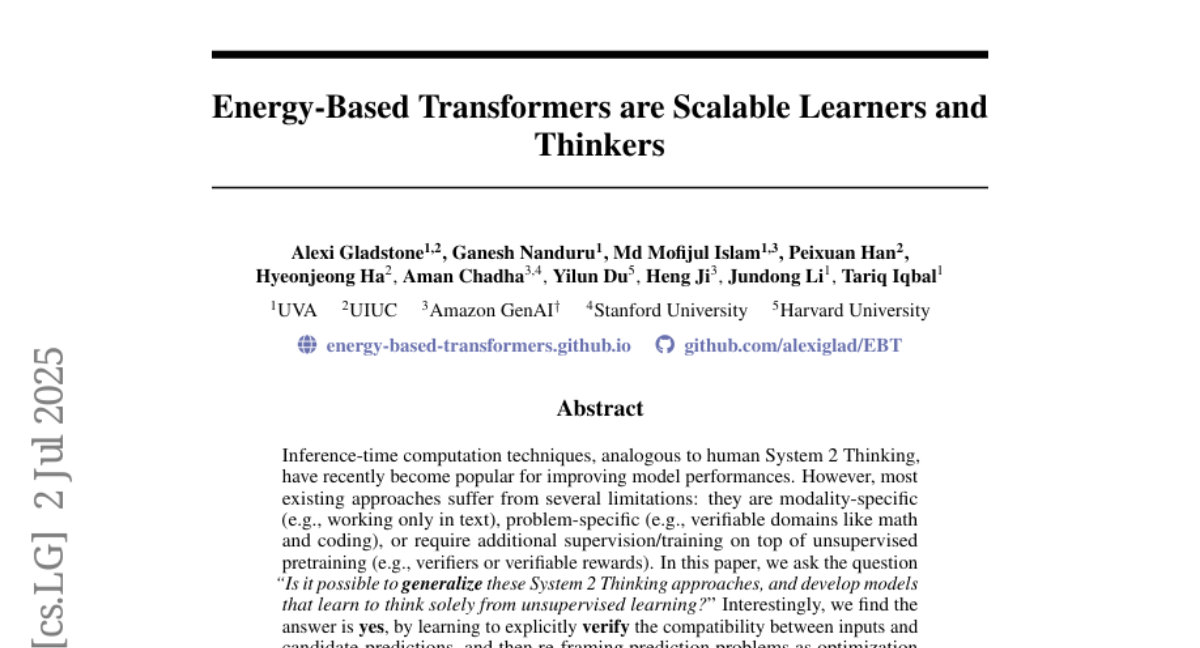
12. Self-Correction Bench: Revealing and Addressing the Self-Correction Blind Spot in LLMs
🔑 Keywords: Self-Correction, Blind Spot, LLMs, Error Injection, Trustworthy AI
💡 Category: Natural Language Processing
🌟 Research Objective:
– To measure the self-correction blind spot in large language models (LLMs), identifying that training primarily on error-free responses contributes to this issue.
🛠️ Research Methods:
– Introduced a framework called Self-Correction Bench to systematically study the self-correction blind spot through controlled error injection at three complexity levels across 14 models.
💬 Research Conclusions:
– Found a 64.5% blind spot rate on average among models, which can be reduced by 89.3% simply by appending “Wait”, indicating the potential to activate self-correction capabilities. The study emphasizes improving LLM reliability and trustworthiness.
👉 Paper link: https://huggingface.co/papers/2507.02778
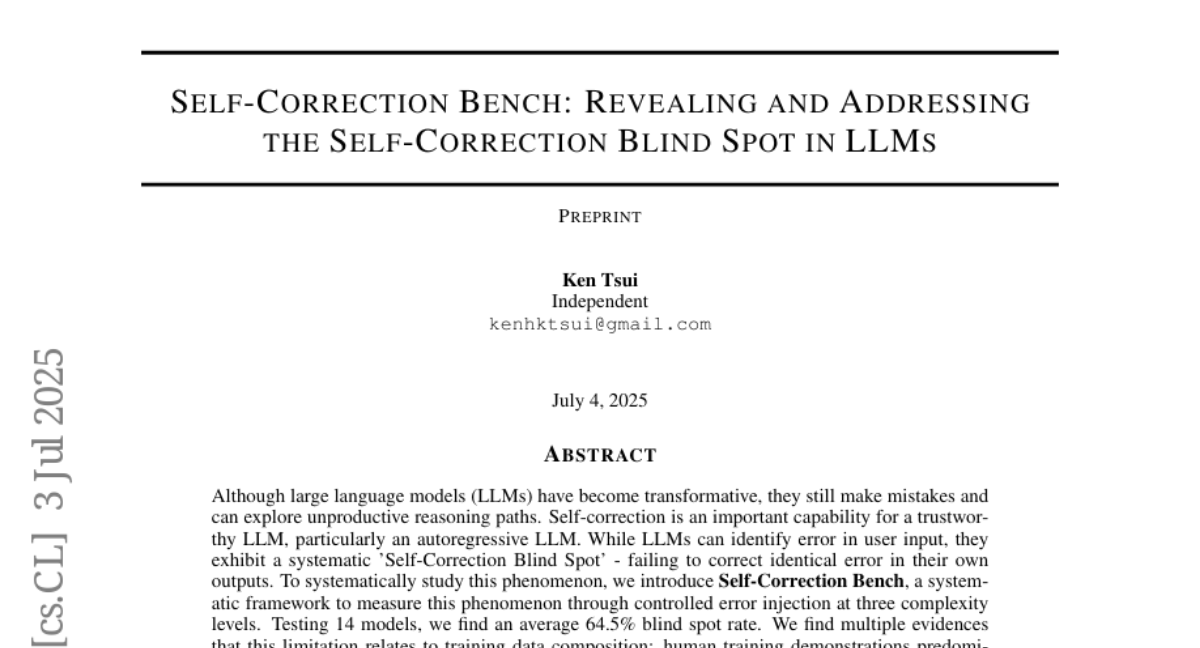
13. Selecting and Merging: Towards Adaptable and Scalable Named Entity Recognition with Large Language Models
🔑 Keywords: SaM framework, domain-specific models, large language models, scalability, information extraction
💡 Category: Natural Language Processing
🌟 Research Objective:
– Propose the SaM framework to dynamically select and merge pre-trained domain-specific models for efficient information extraction tasks.
🛠️ Research Methods:
– Selection of domain-specific experts based on domain similarity and performance on sampled instances, followed by merging to create task-specific models.
💬 Research Conclusions:
– SaM framework improves generalization across various domains without extra training, demonstrating a 10% performance enhancement over unified models. The framework allows convenient scalability through the addition or removal of experts.
👉 Paper link: https://huggingface.co/papers/2506.22813
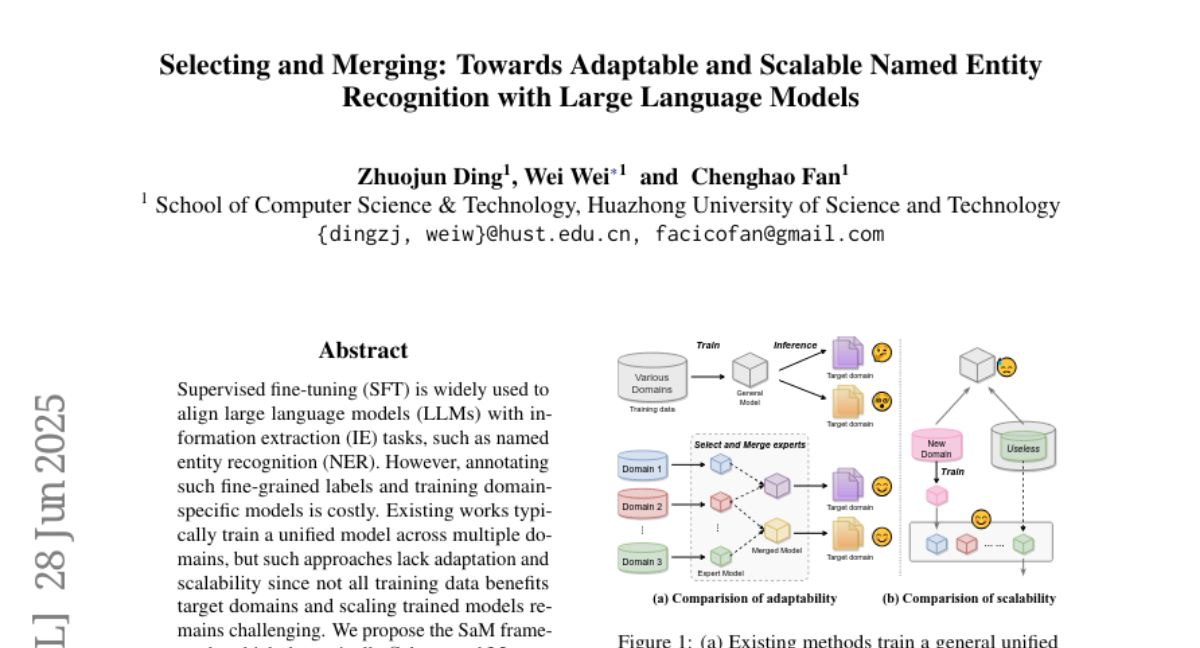
14. ZeCO: Zero Communication Overhead Sequence Parallelism for Linear Attention
🔑 Keywords: ZeCO, Zero Communication Overhead, Linear Attention, Sequence Parallelism, Large Language Models
💡 Category: Natural Language Processing
🌟 Research Objective:
– Introduce ZeCO, a zero communication overhead method for efficient training of large language models with ultra-long sequences across multiple devices.
🛠️ Research Methods:
– Developed a new sequence parallelism method using All-Scan, a collective communication primitive, to reduce communication overhead.
💬 Research Conclusions:
– ZeCO achieves near-linear scalability and improves speed by 60% on 256 GPUs with an 8M sequence length compared to the state-of-the-art methods, enabling efficient training on previously intractable sequence lengths.
👉 Paper link: https://huggingface.co/papers/2507.01004
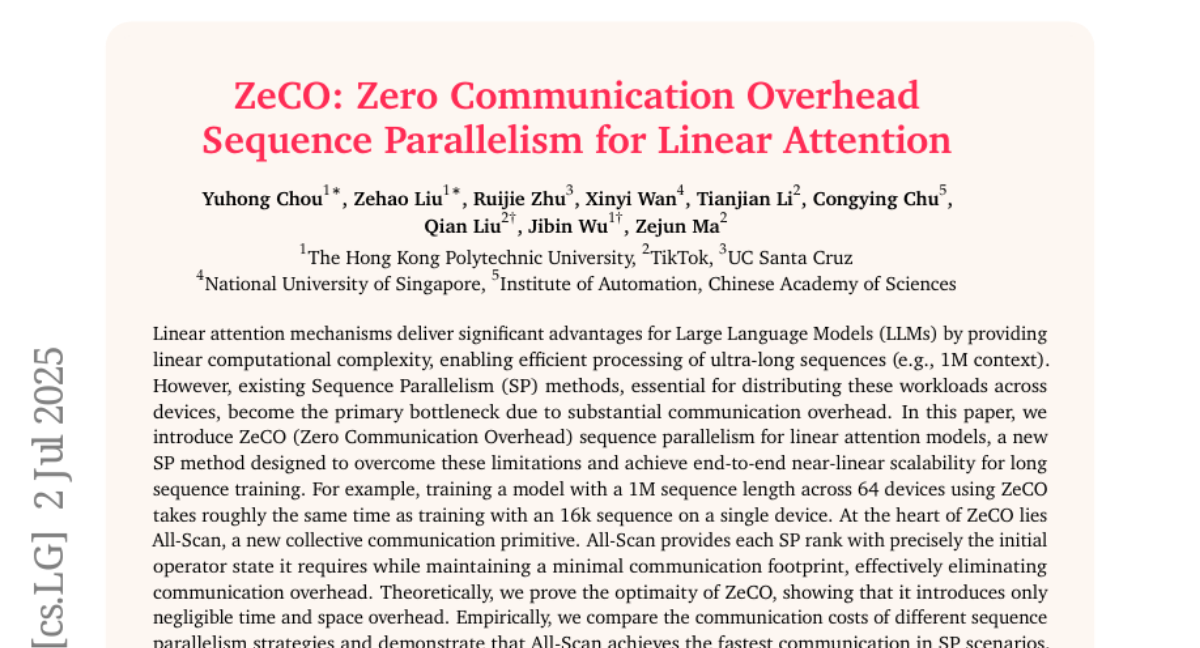
15. AsyncFlow: An Asynchronous Streaming RL Framework for Efficient LLM Post-Training
🔑 Keywords: Asynchronous Streaming, Reinforcement Learning (RL), Large Language Models (LLMs), Distributed Data Storage, Unified Data Management
💡 Category: Reinforcement Learning
🌟 Research Objective:
– The objective is to enhance the efficiency of the post-training phase of large language models through an innovative asynchronous streaming RL framework.
🛠️ Research Methods:
– The study introduces AsyncFlow, which includes a distributed data storage and transfer module, enabling fine-grained scheduling and unified data management. The framework is architecturally decoupled, employing service-oriented user interfaces.
💬 Research Conclusions:
– The framework yields a significant average throughput improvement of 1.59 times compared to baseline methods, providing valuable insights for future RL system designs.
👉 Paper link: https://huggingface.co/papers/2507.01663
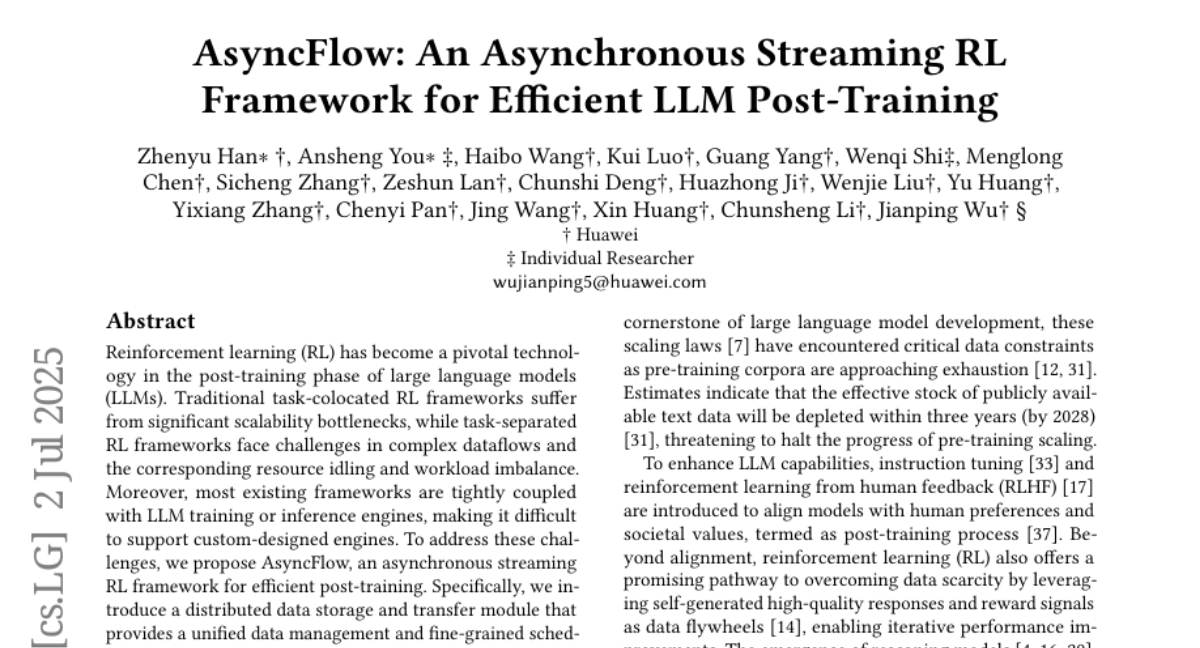
16. HalluSegBench: Counterfactual Visual Reasoning for Segmentation Hallucination Evaluation
🔑 Keywords: HalluSegBench, vision-language segmentation, hallucinations, counterfactual reasoning, segmentation masks
💡 Category: Computer Vision
🌟 Research Objective:
– The objective is to introduce HalluSegBench, a benchmark specifically designed to evaluate hallucinations in vision-language segmentation models through counterfactual visual reasoning.
🛠️ Research Methods:
– HalluSegBench includes a dataset of 1340 counterfactual instance pairs across 281 unique object classes and introduces novel metrics to quantify hallucination sensitivity under visually coherent scene edits.
💬 Research Conclusions:
– The study reveals that vision-driven hallucinations are more prevalent than label-driven ones in state-of-the-art models, indicating a persistent issue in false segmentation and emphasizing the importance of counterfactual reasoning to assess grounding fidelity.
👉 Paper link: https://huggingface.co/papers/2506.21546
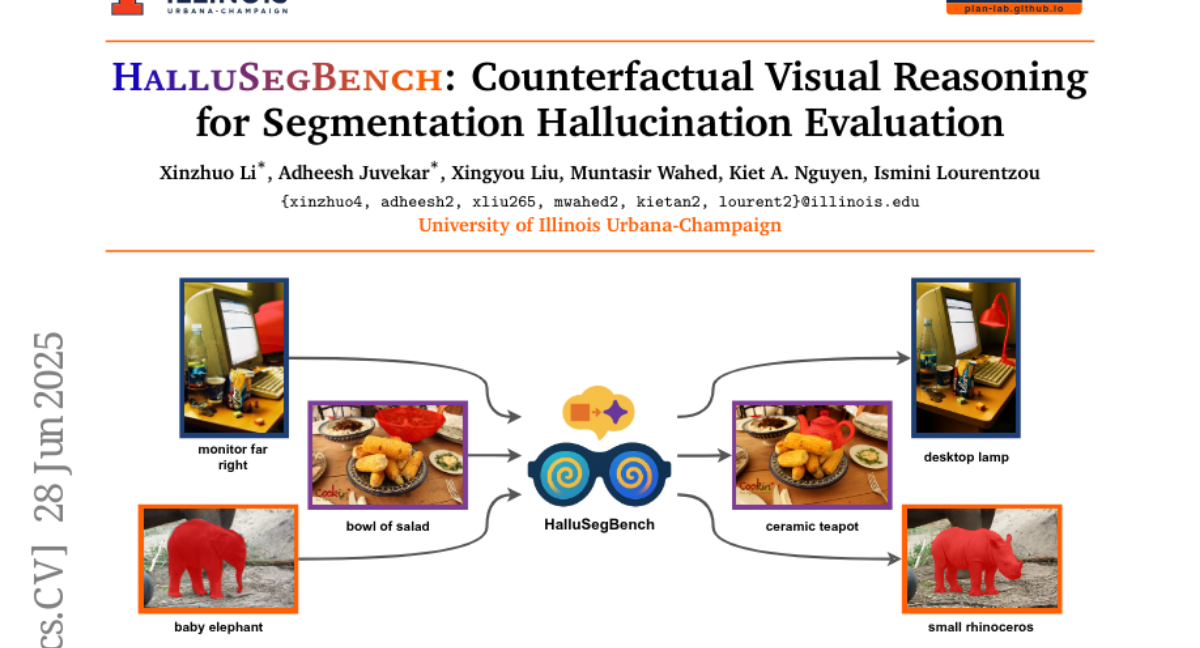
17. CRISP-SAM2: SAM2 with Cross-Modal Interaction and Semantic Prompting for Multi-Organ Segmentation
🔑 Keywords: Multi-organ medical segmentation, CRISP-SAM2, Semantic Prompting, Medical Imaging, AI in Healthcare
💡 Category: AI in Healthcare
🌟 Research Objective:
– To address inaccuracies, geometric dependency, and spatial information loss in multi-organ medical segmentation using a novel approach.
🛠️ Research Methods:
– Developed CRISP-SAM2 model utilizing cross-modal interaction and semantic prompting based on SAM2.
– Employed a progressive cross-attention interaction mechanism to integrate visual and textual data for enhanced image analysis.
💬 Research Conclusions:
– CRISP-SAM2 outperformed existing models in comparative experiments across seven datasets.
– Demonstrated superior performance in addressing previously identified limitations, improving detailed understanding and localization in medical imaging.
👉 Paper link: https://huggingface.co/papers/2506.23121
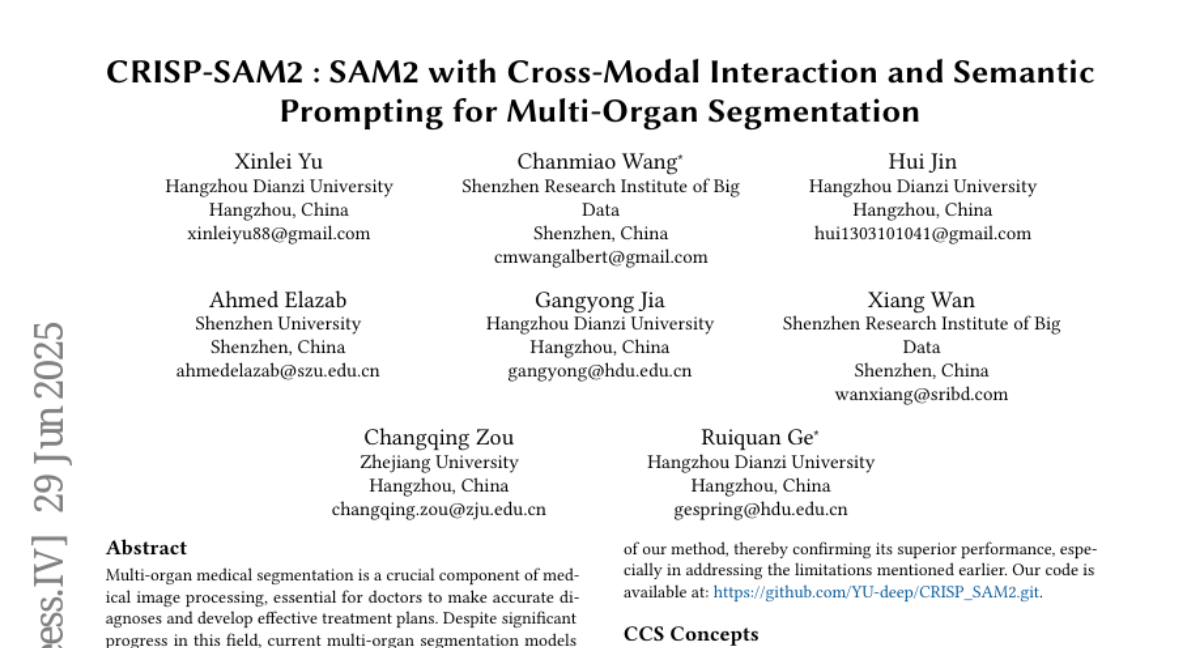
18.
